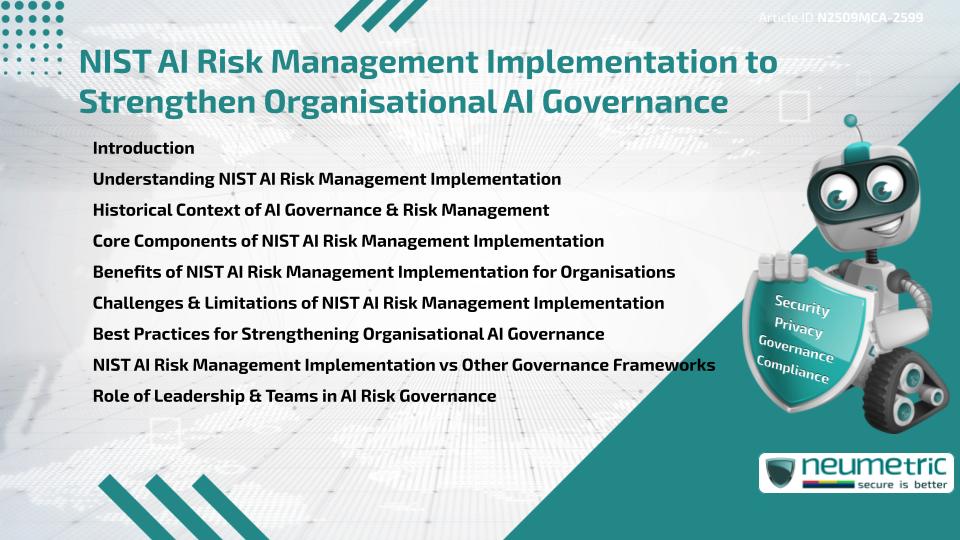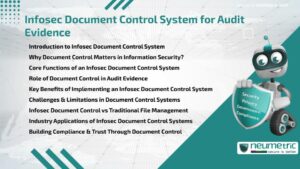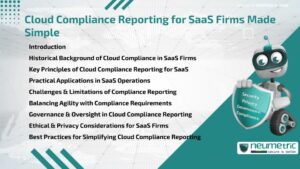Table of Contents
ToggleIntroduction
NIST AI Risk Management implementation is a structured approach to identifying, assessing & mitigating Risks associated with Artificial Intelligence systems. Developed by the National Institute of Standards & Technology [NIST], it provides a Framework that organisations can use to build trustworthy AI while ensuring Accountability & Compliance. For organisations adopting AI technologies, NIST AI Risk Management implementation is essential for strengthening Governance, reducing Vulnerabilities & aligning practices with Regulatory & Ethical Standards.
Understanding NIST AI Risk Management Implementation
The Framework provides guidelines for managing AI Risks across the lifecycle of systems-from design & development to deployment & monitoring. It focuses on principles such as Transparency, Fairness, Accountability & Resilience. Through structured processes, organisations can address technical & social Risks, ensuring AI Systems behave responsibly. The NIST AI Risk Management Framework is voluntary but widely adopted because it offers practical tools & methods for aligning AI Practices with Governance objectives.
Historical Context of AI Governance & Risk Management
AI Governance has its roots in broader Risk Management & Data Protection practices. Early AI Systems raised concerns about Bias, Security & Transparency, sparking calls for structured oversight. Over time, international initiatives such as the OECD AI Principles & regional regulations like the European Union AI Act have expanded Governance requirements. NIST AI Risk Management implementation builds on these global efforts, offering a comprehensive yet flexible model that organisations can adapt across industries.
Core Components of NIST AI Risk Management Implementation
The Framework consists of several key elements:
- Govern: Establish organisational Policies & Roles for managing AI Risks.
- Map: Identify AI System purposes, contexts & potential impacts.
- Measure: Assess Risks, Performance & Ethical considerations.
- Manage: Prioritise, mitigate & monitor Risks throughout the lifecycle.
These components allow organisations to operationalise responsible AI Governance in a structured way.
Benefits of NIST AI Risk Management Implementation for Organisations
The adoption of NIST AI Risk Management implementation provides multiple benefits:
- Stronger alignment with Ethical & Legal standards.
- Improved Trust among Customers, Regulators & Stakeholders.
- Reduced Risk of bias, misuse & operational failures.
- Enhanced ability to Monitor, Audit & improve AI Systems.
Much like Financial Audits protect investors, AI Risk Management frameworks protect organisational reputation & Trust.
Challenges & Limitations of NIST AI Risk Management Implementation
Despite its strengths, organisations may face difficulties in adopting the Framework:
- Complexity of AI Systems: Identifying Risks can be technically challenging.
- Resource Requirements: Smaller organisations may lack the expertise or budget.
- Dynamic Threats: Emerging Risks like adversarial attacks may outpace Framework updates.
These limitations highlight that implementation requires not only technical tools but also ongoing human oversight & cultural adaptation.
Best Practices for Strengthening Organisational AI Governance
Organisations can strengthen Governance by:
- Embedding Risk Management into AI project lifecycles from the start.
- Training staff on Ethical AI Practices & Compliance Requirements.
- Conducting regular Audits & Impact Assessments.
- Using independent oversight to evaluate high-Risk systems.
Such practices transform NIST AI Risk Management implementation from a checklist into a culture of responsible AI.
NIST AI Risk Management Implementation vs Other Governance Frameworks
Unlike sector-specific frameworks such as HIPAA for Healthcare or GDPR for Data Privacy, NIST AI Risk Management implementation provides a broad, cross-sectoral model. It focuses on AI-specific Risks while complementing existing regulatory structures. This integration makes it particularly useful for organisations that operate across multiple jurisdictions & need a flexible but rigorous Framework.
Role of Leadership & Teams in AI Risk Governance
Successful implementation depends on collaboration between leadership & operational teams. Executives must provide Resources, set Policies & champion responsible AI, while teams must apply the Framework to daily operations. Together, leadership & staff ensure that AI Governance is not siloed but embedded across the organisation.
Conclusion
NIST AI Risk Management implementation is a vital tool for strengthening organisational AI Governance. By embedding structured Risk Management processes into AI lifecycles, organisations can build trustworthy systems, align with Global Standards & protect their reputations.
Takeaways
- NIST AI Risk Management implementation addresses Risks across the AI lifecycle.
- Benefits include Ethical alignment, Trust & reduced Vulnerabilities.
- Challenges involve technical complexity, resource demands & evolving Threats.
- Best Practices include early integration, training, audits & independent oversight.
FAQ
What is NIST AI Risk Management implementation?
It is the application of NIST’s AI Risk Management Framework to identify, assess & mitigate Risks in AI Systems.
Why is NIST AI Risk Management implementation important for organisations?
It strengthens AI Governance by ensuring Transparency, Accountability & Compliance while reducing Risks.
What challenges come with NIST AI Risk Management implementation?
Challenges include technical complexity, high resource requirements & evolving Risks such as adversarial attacks.
How does NIST AI Risk Management implementation compare with GDPR or HIPAA?
It is broader & AI-specific, while GDPR & HIPAA address Data Privacy & Healthcare Information Security.
Who is responsible for applying NIST AI Risk Management implementation?
Both leadership & operational teams share responsibility for embedding it into Governance practices.
Does NIST AI Risk Management implementation apply across industries?
Yes, it is designed to be cross-sectoral & adaptable to various organisational contexts.
Need help for Security, Privacy, Governance & VAPT?
Neumetric provides organisations the necessary help to achieve their Cybersecurity, Compliance, Governance, Privacy, Certifications & Pentesting needs.
Organisations & Businesses, specifically those which provide SaaS & AI Solutions in the Fintech, BFSI & other regulated sectors, usually need a Cybersecurity Partner for meeting & maintaining the ongoing Security & Privacy needs & requirements of their Enterprise Clients & Privacy conscious Customers.
SOC 2, ISO 27001, ISO 42001, NIST, HIPAA, HECVAT, EU GDPR are some of the Frameworks that are served by Fusion – a SaaS, multimodular, multitenant, centralised, automated, Cybersecurity & Compliance Management system.
Neumetric also provides Expert Services for technical security which covers VAPT for Web Applications, APIs, iOS & Android Mobile Apps, Security Testing for AWS & other Cloud Environments & Cloud Infrastructure & other similar scopes.
Reach out to us by Email or filling out the Contact Form…





